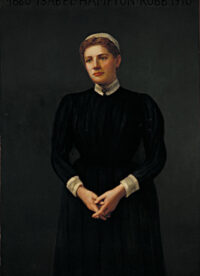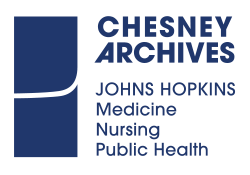Biography
Isabel Adams Hampton was born in Welland, Ontario in August 26, 1859. At age 17, she started work as a public school teacher in Merritton, Ontario. She entered Bellevue Training School for Nurses in New York in 1881 and received her diploma in 1883. Upon graduation, for a few weeks she served as substitute for the superintendent of nurses in the Woman’s Hospital, New York. She then spent two years in Rome as a nurse at St. Paul’s House, which was run jointly by the Protestant Episcopal Church and the Church of England and provided English and American nurses to wealthy travelers in Rome. Upon returning from Rome, she served as a private duty nurse for the Conover family in South Amboy, New Jersey. In 1886 she went to Chicago were she was the superintendent of Illinois Training School for Nurses at Cook County Hospital.
Read More >
In 1889, she came to the newly opened Johns Hopkins Hospital, where she was the first Superintendent of Nurses and Principal of the Training School. Hampton was present in 1890 for the formation of the Women’s Fund Committee, which called for the admission of women into the school of medicine. While Superintendent at Hopkins, she wrote the nursing text book, Nursing: Its Principles and Practices, published in 1893. In 1893 at the World’s Fair in Chicago, she organized the Nurses section of the International Congress of Charities, Correction and Philanthropy, for which she arranged to have Florence Nightingale send an address. Out of these activities, the American Society of Superintendents of Training Schools for Nurses was organized, which would later become the National League for Nurses. She later served as its president. In 1894 she left Hopkins to marry Dr. Hunter Robb, an obstetrician/gynecologist at the Johns Hopkins Hospital. They were married in London, England on July 11, 1894. Florence Nightingale sent Hampton her wedding bouquet. The couple moved to Cleveland, Ohio. They had two sons, Hampton, born Dec. 25, 1895, and Phillip, born Feb. 28, 1902.
Isabel Hampton Robb continued her leadership in the nursing profession locally, nationally, and internationally through her writing, nursing organizations, and activities. She was active in the International Council of Nurses and the Committee to Secure by Act of Congress the Employment of Graduate Women Nurses in the Hospital Service of the US Army, which worked toward the establishment of the Army Nurse Corps. In 1896, Isabel Hampton Robb became the first President of the Nurses’ Associated Alumnae of the United States and Canada, which would later become the American Nurses Association. Robb helped to found the American Journal of Nurses. She was instrumental in establishing the course in Hospital Economics at Teachers College, Columbia University in 1899. She worked to secure a place for professional nurses within the Red Cross Nursing Service. Locally, she served as an advisor to the Lakeside Training School for Nurses in Cleveland and helped found the Cleveland Visiting Nurse Association. She continued to write and give speeches on various nursing topics. She wrote the books Nursing Ethics in 1900 and Educational Standards for Nurses in 1907. She was killed April 15, 1910 in a streetcar accident in Cleveland, Ohio.
< Read Less
Scope and Content
The Isabel Hampton Robb Papers consist of correspondence, writings by Robb, publications from organizations associated with Robb, inspirational books owned by Robb, materials related to the biography of Robb, photographs and material evidence. Most of the correspondence consists of letters to Elizabeth Birdseye, later Mrs. Percival Merritt, whom Hampton met while she was a student at Bellevue. Copies of the correspondence with Florence Nightingale are included; originals are in the Florence Nightingale Collection. Materials related to Robb’s wedding, death and memorial service are also included in the collection. The material evidence consists of Robb’s wedding bouquet, which was sent to her by Florence Nightingale, 2 chairs used by Robb while at Hopkins, and locks of her hair.
Catalog Record
Policy on Access and Use
Permissions and Credits

